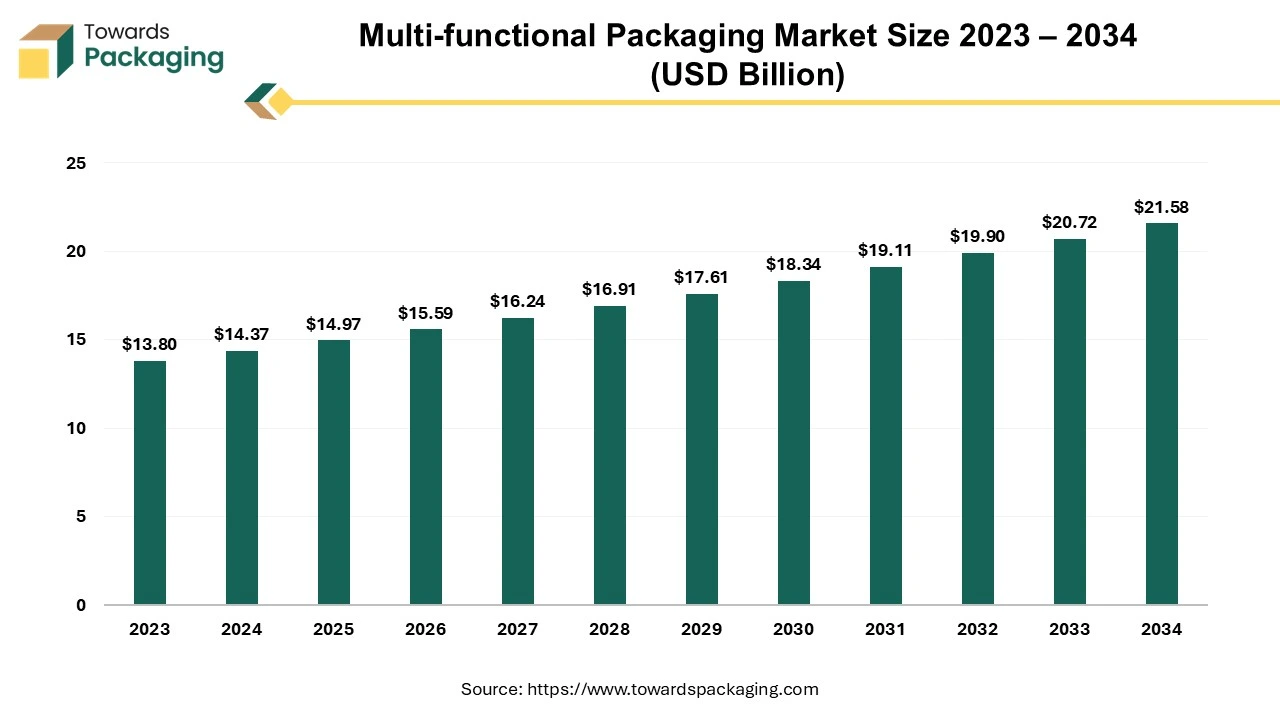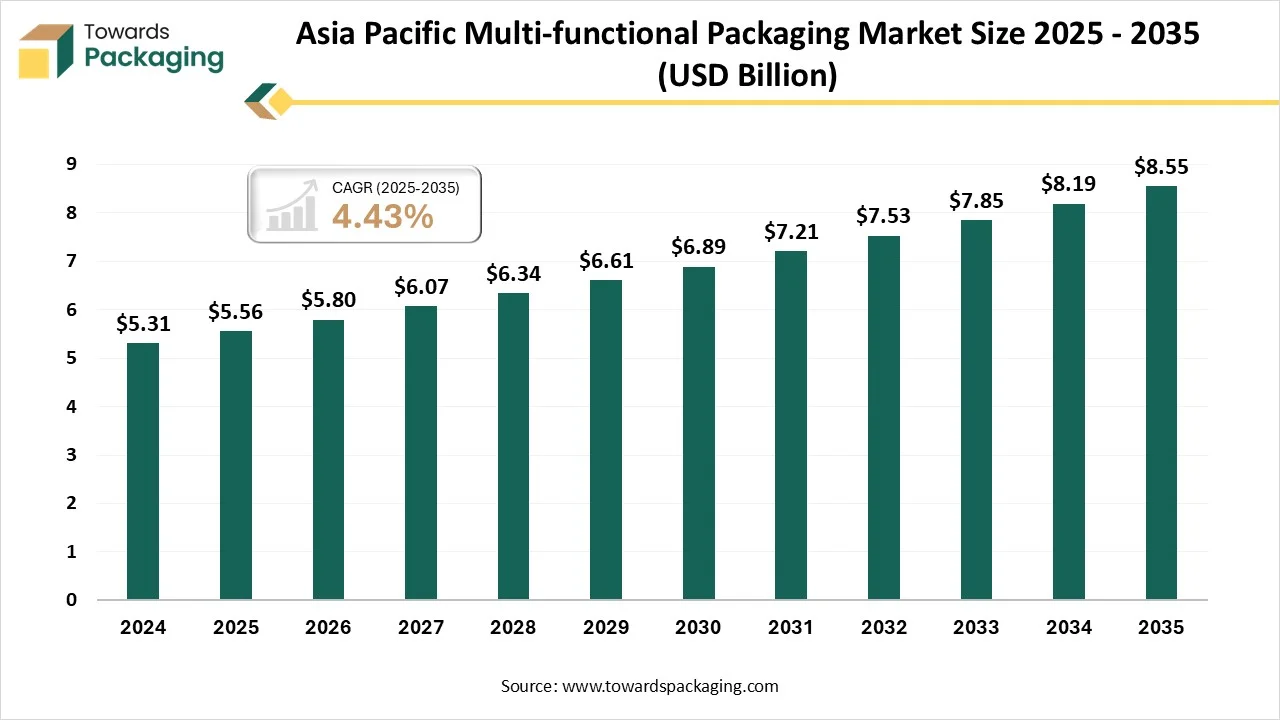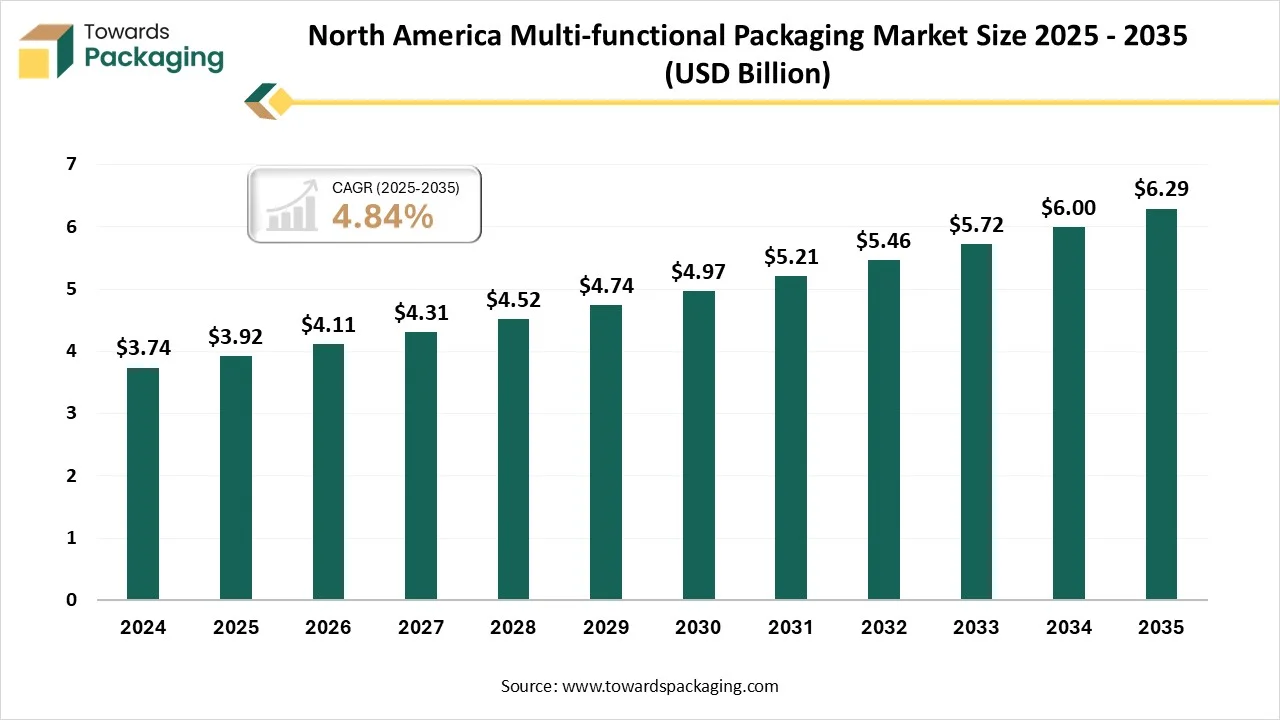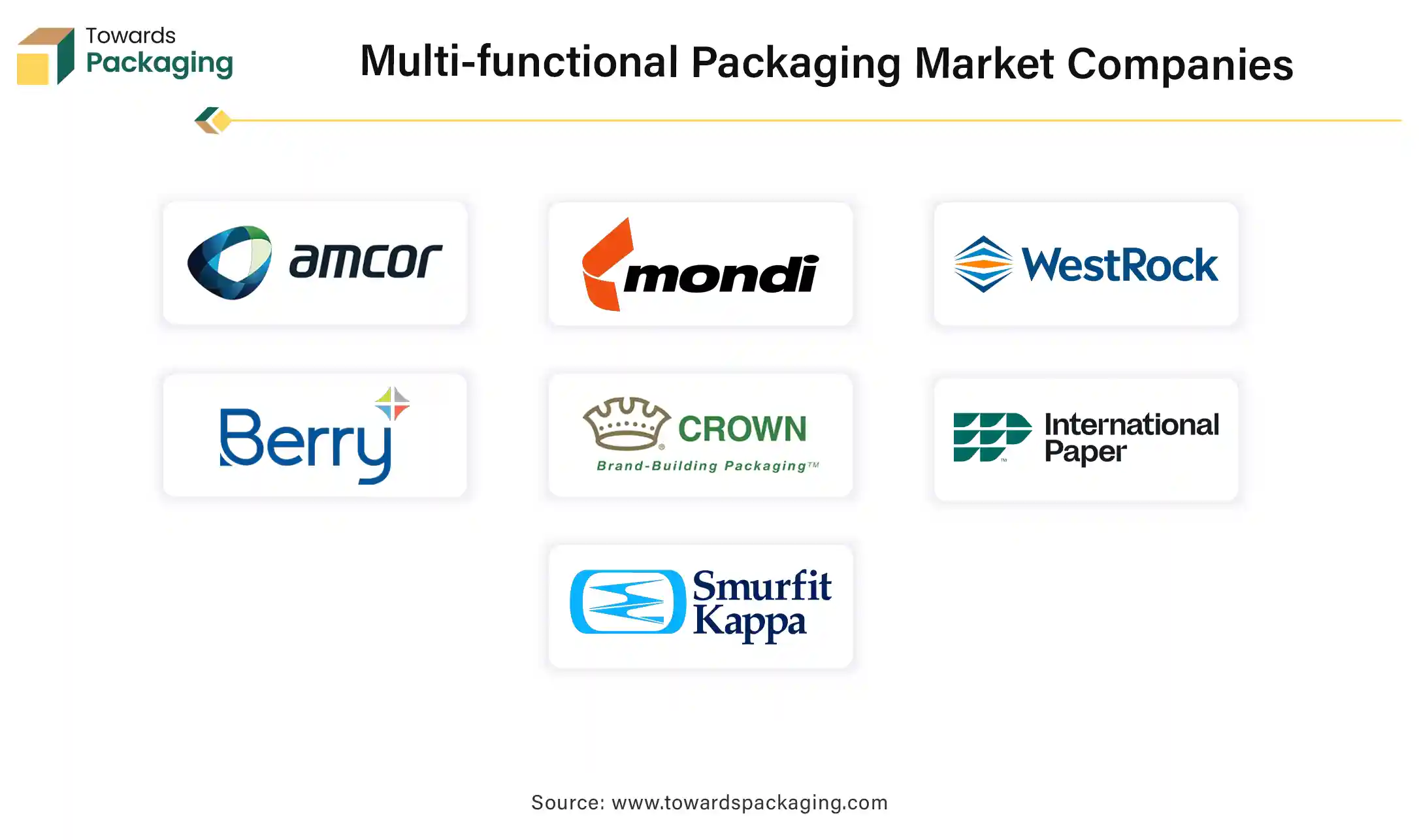November 2025
The multi-functional packaging market is projected to grow from USD 15.59 billion in 2026 to USD 22.48 billion by 2035, reflecting a CAGR of 4.15%. Our report covers the complete statistical landscape, including market size breakdowns, segment-level insights, regional data across North America, Europe, Asia-Pacific, Latin America, and the Middle East & Africa, and company profiling with competitive benchmarking. It further includes value chain analysis, trade flow data, manufacturing trends, supplier information, and import–export statistics, offering a full-picture view of market dynamics.

This market proliferates due to the rising demand for premium packaging quality among people in good economic conditions. It is also fueled by the growing demand for convenient and eco-friendly packaging by customers.
The multi-functional packaging market is rising rapidly due to the increasing demand for convenient packaging for several products that can be reused, resealable, and eco-friendly. Multi-functional packaging is a type of packaging method that delivers added assistance beyond elementary control, such as better-quality product protection, comfort of utilization, and improved brand performance. This market includes an extensive range of submissions, comprising food & beverages, cosmetics, consumer electronics, and pharmaceuticals.
One of the major reasons pushing market development is the growth in customer fondness for ease. Packaging that enlarges the shelf life of the product, delivers easy transportability or includes multiple purposes, such as resealability, tamper-mark, or space regulator, is extremely required. Moreover, the rising importance of sustainability is persuading the demand for environment-friendly, biodegradable, or recyclable packaging resources.
The marketplace is also supported by progressions in skill, with smart packaging resolutions including QR codes, RFID (Radio Frequency Identification), and sensors to observe freshness, track goods data, and improve customer engagement.
The incorporation of AI has brought a significant change in the multi-functional packaging market by enhancing its efficiency, making it cost-effective by reducing labour costs during production, and several others. With the help of cutting-edge technology such as machine learning, automation, and data analytics artificial intelligence can improve packaging patterns, optimize manufacturing methods, and enhance customer experience. With the support of AI smart packaging incorporation by adding QR codes, RFID, and sensors it is possible to observe or track product position in real-time.
This capability is majorly helpful for markets that need precise ecological controls like perishable products and pharmacies. The incorporation of artificial intelligence helps produce packaging which is in high demand in different areas as it recognises the demand of the people living in different places by the gathered information about customers' purchasing. It is also useful in reducing surplus production of packaging products which saves the material wastage as well as manufacturing costs of the companies.
The multi-functional packaging market is driven by various factors one of the prominent reasons is the growing demand for biodegradable packaging solutions. This market uses materials such as paper, cardboard, and many other eco-friendly resources to manufacture packaging which can be used in various ways apart from packaging. Biodegradable resources are attractive and progressively significant in this sector because of the growing apprehension over ecological sustainability.
These resources, which can be converted automatically into non-toxic mechanisms, are gathered from renewable resources such as cellulose, plant starches, and other organic materials. In the packaging market, biodegradable resources are utilized to produce a diversity of products, such as wraps, films, and containers which give an effective defence for products while decreasing ecological influence.
As guidelines constrict and customer likings shift in the direction of environment-friendly choices, the demand for biodegradable resources in packaging is anticipated to grow prominently. Their capability to decompose without causing any harm to the environment makes them an ideal choice for market players who are focusing on enhancing their sustainability identifications.
The growth of smart and interactive technologies of packaging is the most important tendency in the market. Advanced technologies, such as Augmented Reality (AR), QR codes, and RFID tags are being unified into packaging to deliver improved customer engagement and goods tracking systems. Smart packaging choices allow brands to deliver real-time data, collaborating involvements, and tailored content, this improves the customer experience and also offers valued data understanding for producers.
This movement is mainly important in the food & beverage sector, where customer involvement and transparency are progressively important. There is a rising importance on sustainability in the multi-functional packaging sector. Customers and supervisory bodies are searching for packaging methods that decrease ecological influence.
As a consequence, market players are concentrating on emerging environment-friendly multi-functional packaging which is made from decomposable, biodegradable, or recyclable resources. Inventions comprise integrating recycled content, decreasing the utilization of single-use plastics, and manufacturing packaging that reduces waste. This tendency lines up with the worldwide sustainability aim and is anticipated to influence the growth of new, ecologically responsible packaging methods.
The multi-functional packaging market expresses numerous restraints that could delay its development. High production charges connected with unconventional resources, advanced technologies, and sustainable packaging choices can boundary market acceptance, specifically among smaller producers. Moreover, customers' unwillingness to hold new packaging arrangements because of apprehensions over intricacy or higher charges may lower the demand. Supervisory challenges associated with classification, safety morals, and ecological acquiescence also present barricades, particularly as countries execute severe sustainability needs.
The plastic segment led the market with the largest share in 2024. These are highly in demand due to their versatility and durability. Plastic delivers an extensive variety of assistance, it is an ideal resource for numerous applications across trades such as consumer electronics, food & beverages, cosmetics, and pharmaceuticals. Its capability to be molded into a variety of forms, sizes, and shapes permits advanced and personalized packaging choices that fulfil specific useful supplies.
Plastic multi-functional packaging can effortlessly include multiple aspects, such as resealability, tamper-indication, and improved defence against ecological features like light, air, and moisture. Durability is an alternative main aspect that influences plastic’s dominance. Plastic multi-functional packaging is unaffected by effects, weather situations, and management, which confirms that products persist integral and thrive throughout the supply.
Flexible multi-functional packaging is leading the packaging type segment of this market in the predicted period as it plays an important role in the transportation of products as these are cost-effective and lightweight. One of the major factors that influence this market is due to the versatility of flexible packaging of products.
These kinds of packaging are utilized to pack a variety of products from liquids to solids, and these can also be personalized with facilities like easy to open, portion control, and resealability. Such properties fulfil increasing customers' demands such as easy to use. Flexible packaging also offers defence, delivering barricades against moisture, light, and oxygen, which is particularly critical for protecting food freshness and spreading shelf life.
Moreover, flexible packaging delivers design flexibility, permitting better-quality prints and attractive graphics, which improve labelling and customer appeal. This blend of aesthetic visuals, functionality, and sustainability has hardened flexible packaging management in the multi-functional packaging market.
The food segment held the largest share of the market in 2024 and is seen to sustain the position throughout the forecast period as it is important due to the evolving choices of the customers. A wide variety of customers prefer to consume products which have sustainable, convenient, and extended shelf-life potential packaging.
Multi-functional packaging offers the capacity to integrate several aspects such as portion control, protection, resealability, and tamper-evidence. The rising demand for sustainable packaging solutions are major aspect in this sector. With growing consciousness about ecological concerns, the food sector is looking for environment-friendly, biodegradable, or recyclable packaging choices. This tendency is anticipated to continue as customer experiences and technical revolution.

Asia Pacific held the largest share of the multi-functional packaging market in 2024. This is due to the growing focus towards developing sustainable packaging solutions, urbanization, and changing customer demand. Countries such as India, China, Japan, Thailand, and South Korea have made noteworthy contributions to the growth of this market as these are progressively investing in developing enhanced quality packaging which can keep food items fresh for longer periods.
This demand is for aesthetically and functional packaging solutions which raise the potential of the market players. With the growing innovative technology incorporation, all the market players are introducing significant changes resulting in the development of the market.

North America is observed to grow as a fastest growing region in the market during the forecast period. This is majorly due to the rapid advancement in the technologies used by the packaging companies. Continuous research and innovation in countries such as the US, and Canada have influenced the growth of this market rapidly. With the advancement of technology majorly AI has influenced the packaging sector to grow rapidly in this region. The major reason behind the growth of this market is due to rising technology.

By Material Type
By Packaging Type
By End-Use
By Region Covered
November 2025
November 2025
November 2025
November 2025